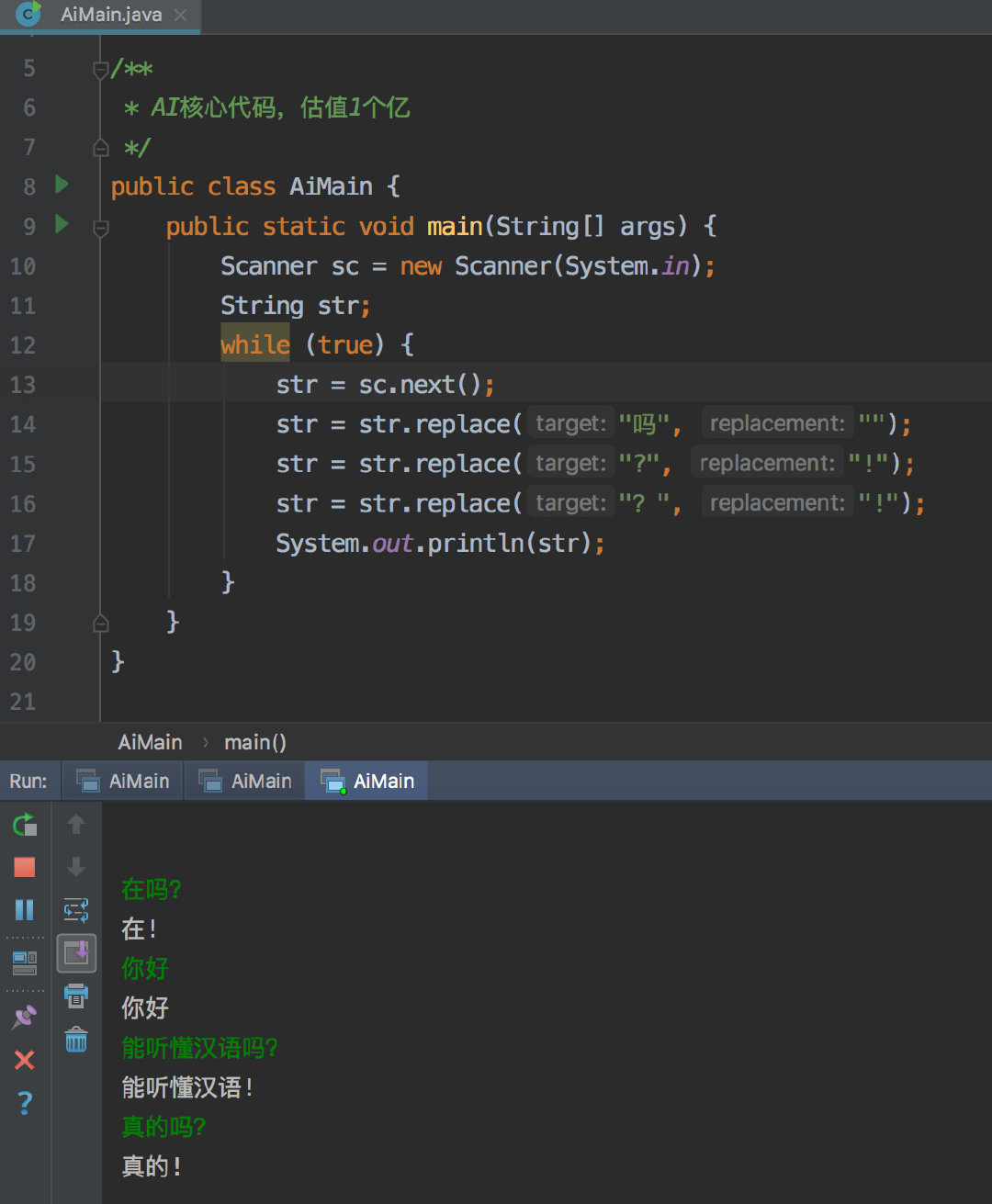
以上图片来自新浪微博。
本题要求你实现一个稍微更值钱一点的 AI 英文问答程序,规则是:
- 无论用户说什么,首先把对方说的话在一行中原样打印出来;
- 消除原文中多余空格:把相邻单词间的多个空格换成 1 个空格,把行首尾的空格全部删掉,把标点符号前面的空格删掉;
- 把原文中所有大写英文字母变成小写,除了
I; - 把原文中所有独立的
can you、could you对应地换成I can、I could—— 这里“独立”是指被空格或标点符号分隔开的单词; - 把原文中所有独立的
I和me换成you; - 把原文中所有的问号
?换成惊叹号!; - 在一行中输出替换后的句子作为 AI 的回答。
输入格式:
输入首先在第一行给出不超过 10 的正整数 N,随后 N 行,每行给出一句不超过 1000 个字符的、以回车结尾的用户的对话,对话为非空字符串,仅包括字母、数字、空格、可见的半角标点符号。
输出格式:
按题面要求输出,每个 AI 的回答前要加上 AI: 和一个空格。
输入样例:
6
Hello ?
Good to chat with you
can you speak Chinese?
Really?
Could you show me 5
What Is this prime? I,don 't know
输出样例:
Hello ? AI: hello! Good to chat with you AI: good to chat with you can you speak Chinese? AI: I can speak chinese! Really? AI: really! Could you show me 5 AI: I could show you 5 What Is this prime? I,don 't know AI: what Is this prime! you,don't know
考完研来补题,当时比赛没做出来,只得了部分分,说到底是考虑的情况不全。
补一下样例
输入:
7
?
can you?
I 'm your father !
can .
can
I?
me.
输出(AI部分):
AI: !
AI: I can!
AI: you'm your father!
AI: can.
AI: can
AI: you!
AI: you.
代码:
#include <stdio.h> #include <string.h> #include <ctype.h> int n,len; char s[1050],t[1050]; void print(char *str,int *c) { if(!isalnum(str[*c])) { printf("%c",str[*c]); *c += 1; if(str[*c] == ' ') *c += 1; return; } if(*c && str[*c - 1] == ' ') printf(" "); char temp1[1050],temp2[1050] = ""; sscanf(str + *c,"%s",temp1); if(strcmp(temp1,"I") == 0 || strcmp(temp1,"me") == 0) { printf("you"); *c += strlen(temp1) + 1; } else if(strcmp(temp1,"can") == 0 || strcmp(temp1,"could") == 0) { *c += strlen(temp1) + 1; if(*c < len) { sscanf(str + *c,"%s",temp2); } if(strcmp(temp2,"you") == 0) { printf("I %s",temp1); *c += strlen(temp2) + 1; } else printf("%s",temp1); } else { printf("%s",temp1); *c += strlen(temp1) + 1; } } int main() { scanf("%d",&n); getchar(); for(int i = 0;i < n;i ++) { int k = 0,c = 0; while((s[k] = getchar()) != ' ') { if(s[k] == ' ') { if(c && t[c - 1] != ' ') t[c ++] = ' '; } else if(!isalnum(s[k])) { if(c && t[c - 1] != ' ') t[c ++] = ' '; if(s[k] == '?') t[c ++] = '!'; else t[c ++] = s[k]; } else { if(s[k] != 'I') t[c ++] = tolower(s[k]); else t[c ++] = s[k]; } k ++; } while(t[c - 1] == ' ') c --; s[k] = 0; t[c] = 0; printf("%s AI: ",s); len = c; c = 0; while(c < len) { print(t,&c); } printf(" "); } return 0; }